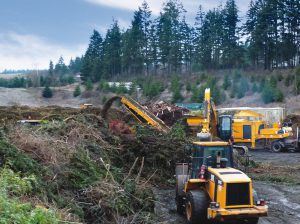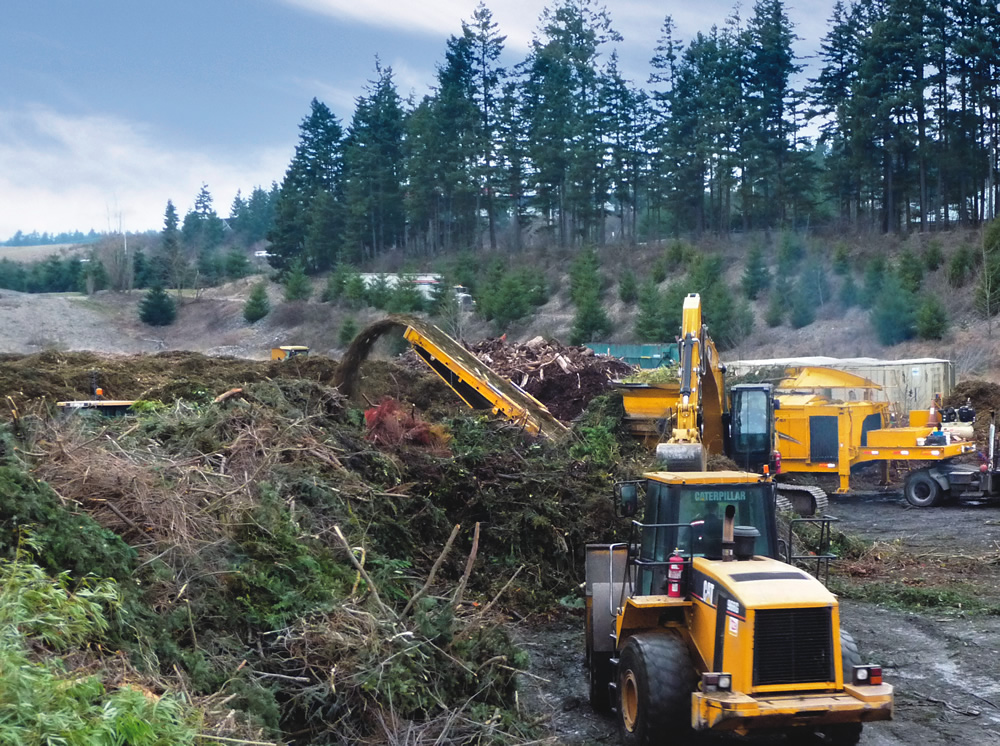Green waste processing volume nearly tripled, literally overnight, at a Washington State recycling facility.
Randy Happel
BioCycle August 2013, Vol. 54, No. 8, p. 30
In mid-January 2012, a winter storm moving inland from the Pacific Ocean blanketed an 11-county area of Northwest Washington with several inches of heavy wet snow, followed by a thick layer of ice that coated everything from sidewalks to skyscrapers. Nicknamed “Snowmageddon,” by locals, the storm first walloped the Seattle and Tacoma metro areas, shattering a 60-plus-year record snowfall total at Sea-Tac International Airport, before fanning out to other parts of the state.
Widespread power outages were commonplace. Airports, offices and schools were closed, and traffic was severely snarled — the result of numerous accidents and roadways made impassible by downed tree limbs and fallen debris. The situation was so dire in some locations that state troopers were performing tree-care duties in addition to their regular patrol responsibilities.

More than 95 percent of the 19,286 tons of storm debris delivered to Pierce County Recycling were processed by the facility’s Vermeer TG7000 tub grinder.
And although short-lived, the storm’s impact was profound. Vegetation bore the biggest brunt of the estimated $33 million in damage, especially ornamental and deciduous trees with many encased in more than a quarter-inch of ice. The aftermath of this uncharacteristic Pacific Northwest weather event stretched on for weeks, presenting area landfills and organic recycling centers — including Pierce County Recycling located near Puyallup — with unprecedented volumes of green waste.
From January 20 through February 26, 2012, the period declared by the Federal Emergency Management Agency (FEMA) as the official emergency county storm event, Pierce County Recycling was consistently processing more than 520 tons/day of green waste. “Compare that to the less than 200 tons we grind in the course of a normal day during the winter,” says Don Taylor, the company’s assistant district manager who also oversees all composting operations. “And the debris was all limbs. It was an immense volume.”
Pierce County Recycling was founded in the late 1970s and is one of several composting and recycling centers, landfill collection sites and transfer stations within the Pierce County Recycling, Composting & Disposal umbrella. In 2001, the company was acquired by Waste Connections. Taylor also manages the organization’s trucking operations for organics. During the storm clean-up, he faced the logistical challenge of moving more than 1,000 vehicles through his facility during the first few days, as well as kept track of the dozens of semis that had joined the storm debris hauling effort.
“In the two days immediately following the storm, we counted 2,555 vehicles in the parking lot and a line that stretched more than a mile long,” recalls Taylor. “We were able to safely process all the material in 10-hour shifts. “I was also importing, on the average, about 30 semitrailer loads daily to this site from our satellite facilities, so all the debris was brought here and run through our main grinder. Those were easily record hauling and green waste processing days for this facility.”
Taylor estimates that more than 95 percent of the 19,286 tons of ornamental branches, evergreen boughs and assorted deciduous storm debris delivered to Pierce County Recycling were processed by the facility’s Vermeer TG7000 tub grinder. The deep tub capacity on the unit allows for bulky, bushy-type debris to reach the bottom of the tub versus having to facilitate that process by pushing it down with the clamp attachment on the loader. “Because of this feature, we were able to have two loaders filling the tub of the grinder as quickly as possible because the debris wasn’t getting caught up midway in the tub,” he explains.
Multiple End Uses
While the ice storm and resulting surge of bulky, woody debris received was an anomaly, there are occasions throughout the course of a normal year when the volume processed by the grinder does approach peak capacity — at least temporarily — largely due to the density of the organic material being fed. The stump pile is an example. “We take stumps for free, so every year the pile gets very large,” Taylor says. “We then dedicate the grinder to processing nothing but stumps, for however long it takes. This past year, the grinder ran through the entire pile in six hours — a process that previously would take us upwards of two weeks to complete.” He adds that the ability to run everything on the yard through one grinder is of great advantage to the operation’s efficiency.
Taylor had projected to local regulatory bodies and supervisors that it would take up to three years to dispense of all the processed storm debris. But in working with local county officials, and relying on his 20-plus years of experience in the recycling and composting industry, he was able to identify several different sustainable end uses for the processed fiber in one year. In excess of 6,000 yards of ground material were shipped to local river, creek and reforestation projects within the county. And by late January 2013, Pierce County Recycling shipped the last of the processed organic storm debris — 92 semitrailer loads used by a local pulp mill as biomass boiler fuel.
“Through the whole storm ordeal, my biggest concern was space,” he notes. “Even though it’s a relatively large facility, in order to physically be able to have that amount of processed organic debris on site — even ground up — was a great concern. At one point I had over 65,000 cubic yards already ground up and stockpiled next to my building. And we were shipping 20 semiloads a day out of our system at the time. It was just the sheer enormity of it all that was of great concern.”
The ability to create a good quality, consistently ground material helped uncover productive uses for it. “Normally, we don’t create landscaping mulch, but we worked with the local regulator and wholesalers and ended up marketing about 8,000 cubic yards of mulch,” Taylor explains.
Randy Happel is a features writer with Two Rivers Marketing in Des Moines, Iowa.










